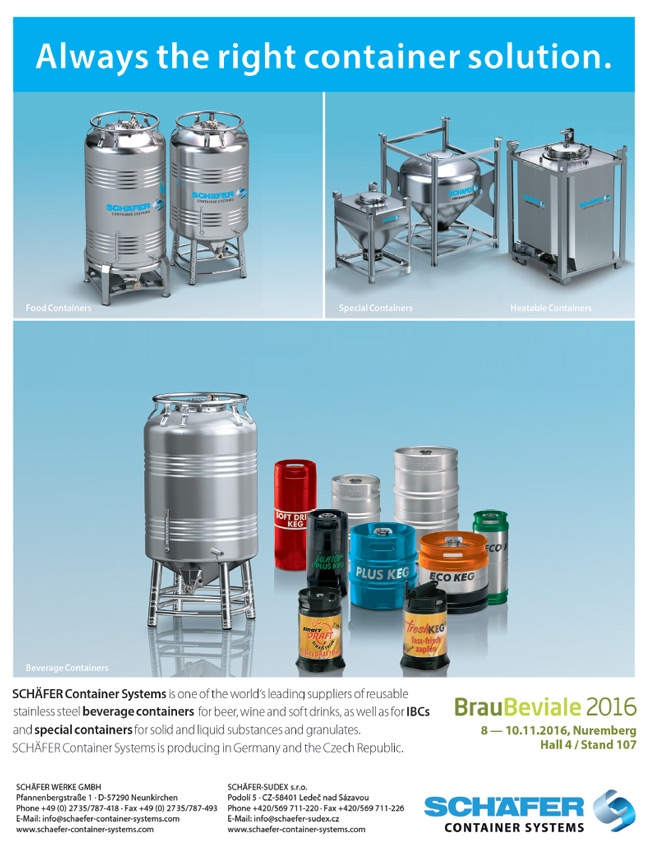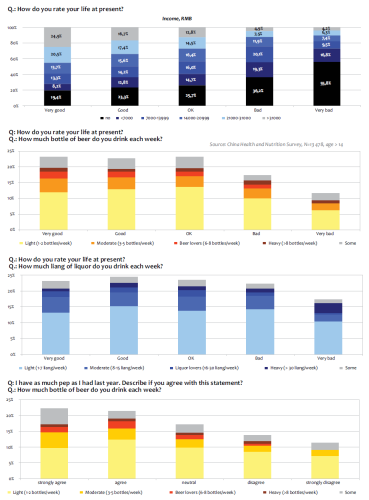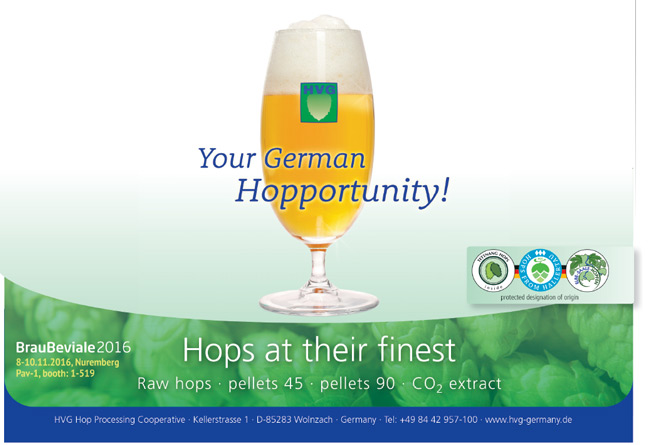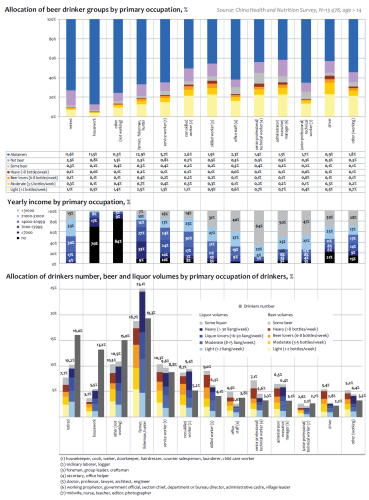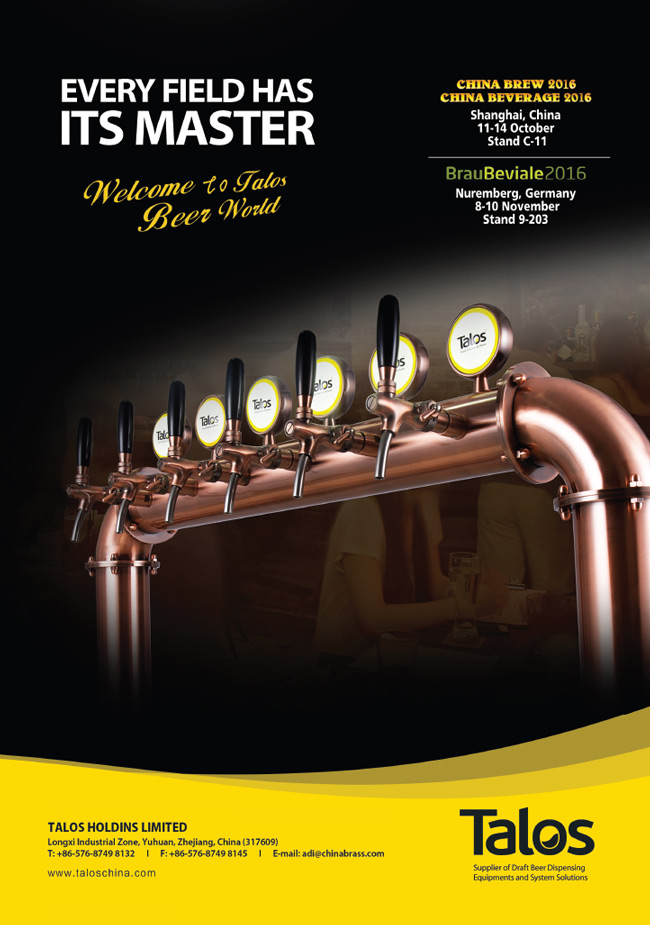In order to determine the fundamental reasons for the Chinese market reduction and particularly its cheap segment, let us consider the social factors affecting the volumes of beer consumption. And then, we will analyze how they could change in the past years.
How often do Chinese drink beer?
During the survey, …% of the Chinese over 14 answered positively to the question “Did you drink beer or any other alcoholic beverage in the previous year?” This figure seems to be underestimated due to self-censorship or other reasons.

 Among the Chinese who consume alcoholic drinks, … said they drank beer. They were divided into groups* so that the consumed volume was approximately equal. If we exclude those who did not remember how much they drank, it will become clear that:
Among the Chinese who consume alcoholic drinks, … said they drank beer. They were divided into groups* so that the consumed volume was approximately equal. If we exclude those who did not remember how much they drank, it will become clear that:
* A very large number of people consuming 1-2 bottles did not let divide the groups proportionally.
- …% of people consume 1-2 bottles per week. Let us name them “light” consumers.
- …% of people consume 3-5 bottles per week. Let us name them “moderate” consumers.
- Group “beer lovers” includes those who drink 6-8 bottles per week. Their share is …%.
- Consumers drinking more than 8 bottles per week belong to “heavy” group and amount to …% of all consumers.
Finally it was found out that …% of heavy consumers drink up …% of all consumed beer. And if we exclude “light” consumers, then the remaining … drinks up …% of beer. This most drinking third part can be called the core and paid special attention to, when analyzing the consumption.
Ageing of China’s population is considered to be one of the reasons for the growth slowdown and subsequent decline of the beer market. According to Worldometers, in 2016, the median age in China is 37.3 years, though in 2000 it was 30. This is a significant change, as age markedly influences the beer consumption volume.
Most beer consumers belong to population group of 20-50 years old*. That is, they are young people who finish education and start working as well as employed adults. But the demographic changes in China seriously affected young group of 20-29, who can become beer consumers.
* Consumers were divided by age so that the age groups were approximately equal by number of people in them.
Basing on data by United Nations Population Division one can see that from 2005 to 2010, when the Chinese beer market was growing at high rates, the number of people aged 20-29 was increasing too. As their number dynamics was twice behind, it can be considered that the fast market rise till 2010 was by half caused by demographic factor.

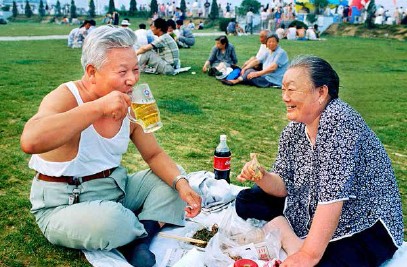 But till approx. 2012 this factor ran out of steam which we can tell by the slowed market growth rate. The policy of family planning introduced in China in the 1970’s led to decreasing in the number of young consumers’ group.
But till approx. 2012 this factor ran out of steam which we can tell by the slowed market growth rate. The policy of family planning introduced in China in the 1970’s led to decreasing in the number of young consumers’ group.
Thus, we can hardly hope for restoring of high market growth rates even if the structural problems in the economy were solved. Besides, at this moment, the main consumers’ group is starting to decrease rapidly. For this reason, the next decade will be difficult for the Chinese brewers who will have to think how to keep the ageing consumers loyal. No sooner than by 2025, the negative effect will lose its steam and the situation will start changing for the better.



However, there is a peculiarity that makes the population ageing not so dramatic. There is a certain “tableland” both in the share of beer consumers and in the consumption level within the ages from 25 to 48. It makes China different from other countries, such as Russia and Western Europe, where the pronounced reduction of consumers’ number and consumption level begins at 35 years and falls rapidly with aging. In other words, in China, beer is not an exclusively youth drink.

The data on allocation of non-drinkers, beer non-drinkers, and beer drinkers are similar to other countries, but there are also some peculiarities. One can see, there is a growing number of people who though may drink alcohol sometimes, still prefer spirits to beer. This share is growing in the first place due to gradual non-drinkers involvement.
Gender and beer consumption
 Chinese women unlike Europeans practically do not drink beer. According to the survey, only …% of them have consumed alcohol in any considerable volumes. For comparison, in Russia the share of women drinking beer is twice bigger.
Chinese women unlike Europeans practically do not drink beer. According to the survey, only …% of them have consumed alcohol in any considerable volumes. For comparison, in Russia the share of women drinking beer is twice bigger.
For this objective reason, our “beer sociology” concerns men almost solely. Here we should also keep in mind that women drink very little in general or at least try not to demonstrate it, starting self-censorship for the survey. Only …% of them admitted consuming alcohol over a year. Even wine, let alone spirits, is mostly consumed by men. However, in the recent years, there has been a growing interest among girls to low-alcohol bottled cocktails, wine, as well as specialty and premium beer sorts sold in HoReCa.
Income and beer consumption
Involvement into alcohol consumption is much dependent on the Chinese’s income level. In this peculiar wellbeing indicator, beer occupies the middle position between wine (the drink of wealthy people) and liquors drunk also by many unwealthy people. But if we do not include those who have no earnings at all, we will see the link of consumers’ number and the income size in the three main categories of drinks.

The liquor consumption has its peculiarity – the least wealthy group is the biggest and includes a rather high percentage of people who drink much – more than 30 liangs * in a week. Thus, if we consider not the consumers’ number but the dependence of the total volume of drunk liquor on incomes, we will see a sagging between groups by income. And in general, one can notice that in terms of volume, the income/consumption dependence weakens. In case of liquors we speak of a minor difference in volumes allocation by incomes.
* 50 ml.
Clear dependence of alcohol consumption on the income level (or well-being) is showed by many other scientific researches published in medicinal journals.
Alcohol and social adaptation
Well-being and success are extremely important for the Chinese. There is a distinct dependence of income group on how they see their lives. In the group with a high income level only 9% evaluate it as “bad” or “very bad”. In the low income group this share equals 36%.
There is not much difference in the structure and types of beer consumption among people that said that their lives are “OK”, “good”, and “very good”. Yet those who live “poorly” drink much less and those with “very bad lives” very frequently refuse to drink alcohol at all. By the way approximately the same picture we have in liquor consumption.
Worsening of life compared to the previous year (that is a dynamic assessment) inevitably means abstinence. This means that income loss, status decline or dismissal threat for big groups of people can significantly affect the beer market.
The growth of both consumers’ number and alcohol consumption volumes for wealthier Chinese results not only from higher affordability but also from more developed social connection. Alcohol is considered an important tool of social communication in Chinese culture, especially for male drinkers.
From ancient times to now, drinking behavior has been deemed a useful and necessary social skill in Chinese society. Some parents even encourage older adolescents who are about to start their career, especially males, to drink alcohol.
 Here we have surveys carried out among students of various groups*. Better off students drank more on the one hand because they had more possibilities and resources. On the other hand, from childhood they have realized the importance of social connection for their parents’ career. Drinking hability becomes an important skill and associates with successful life. Besides, a big role in alcohol consumption is played by the western culture of consumption and leisure, where the youth drinks quite much.
Here we have surveys carried out among students of various groups*. Better off students drank more on the one hand because they had more possibilities and resources. On the other hand, from childhood they have realized the importance of social connection for their parents’ career. Drinking hability becomes an important skill and associates with successful life. Besides, a big role in alcohol consumption is played by the western culture of consumption and leisure, where the youth drinks quite much.
*Alcoholic beverage preferences and associated drinking patterns by socioeconomic status among high-school drinkers in three metropolises of China. Asia Pac J Clin Nutr. 2016;25(1):184-94. doi: 10.6133/apjcn.2016.25.1.20.
In another survey* students, not being active alcohol consumers at the beginning, found themselves inclined to drinking by the end of studying. Senior students, engaged in professional activity during summer vacations, drank more.
* Drinking Patterns and the Association between Socio-Demographic Factors and Adolescents’ Alcohol Use in Three Metropolises in China. Int J Environ Res Public Health. 2015 Feb; 12(2): 2037–2053.
As shown in the next chapter, the alcohol use is to a big extent determined by professional necessity. The higher professional or career status is the more likely the person is to drink more alcohol (or beer).
Employment and beer consumption
Belonging to a certain professional group influences the beer consumption significantly. Same as unemployment. Among the respondents, …% of employed people drink up …% of all consumed beer.
The reasons for such distribution are clear. Unemployed people are mostly retired and people with low income most of who are housewives.
We have already mentioned that women in China do not much like alcohol. Among the retired we can see rather understandable abstinence with aging, but there is also a marked shift toward strong alcohol. One of the obvious reasons is that beer was far not so popular at the time of habit-forming of the older people. For other categories of jobless people preference of liquors can be explained by a rational approach to alcohol consumption due to low incomes or sometimes by alcoholism.
Approximately the same influence is exerted on the consumption structure by the rationalism of the country dwellers employed mostly at farms. Being the biggest by number group of the employed (the fifth part of the adult respondents), farmers drink up disproportionally little as compared to other groups. Their preferences are obviously on the side of strong spirits bai jiu (see chapter Beer vs Liquors).
 Low-skilled workers occupy a transient position between the professional groups. Their average level of income is higher than the farmers but still not high. They drink quite much beer but the consumption structure gravitates toward hard liquors.
Low-skilled workers occupy a transient position between the professional groups. Their average level of income is higher than the farmers but still not high. They drink quite much beer but the consumption structure gravitates toward hard liquors.
The service sector employs a lot of women, so despite rather high number of the group, its contribution into alcohol (and beer in particular) consumption is disproportionally less. Junior professional staff (teachers, nurses and others) also drink comparatively little.
A variety of other professional groups (see the table) are well provided according to their professional or career hierarchy. Their alcoholic preferences are shifted toward beer. In aggregate, these groups account for only …% of adults and …% of consumed beer. Obviously they are the main consumers of premium and import beer.
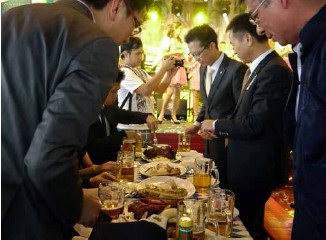 As we have already noticed, drinking hability is an important skill for a manager or an officer, which helps in the career. Taking into account the traditional role of alcohol for developing business and social links, it is quite understandable that the managers and experienced workers stand out from the rest of the social groups. During the riot economy development, and distension of investment bubble, a whole culture of corporate parties, banquets, restaurant business meeting has been formed.
As we have already noticed, drinking hability is an important skill for a manager or an officer, which helps in the career. Taking into account the traditional role of alcohol for developing business and social links, it is quite understandable that the managers and experienced workers stand out from the rest of the social groups. During the riot economy development, and distension of investment bubble, a whole culture of corporate parties, banquets, restaurant business meeting has been formed.
However, due to the difficult transition to “the new normal” impertinent behavior and spending much on banquets and alcohol does not pertain to officers who must set an ethical example. Besides it is quite understandable that some branches of private business reduce their spending.
To get the full article “Analysis of beer market in China” in pdf (60 pages, 65 diagrams) propose you to buy it ($45) or visit the subscription page.
2Checkout.com Inc. (Ohio, USA) is a payment facilitator for goods and services provided by Pivnoe Delo.


